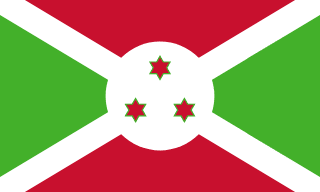Burundi - Geography

Here, let us take a look at the Geography of Burundi. Landlocked; straddles crest of the Nile-Congo watershed; the Kagera, which drains into Lake Victoria, is the most remote headstream of the White Nile. Mother's mean age at first birth is 21.5 years (2016/17 est.) (Note: data represents median age at first birth among women 25-49), whereas, the Maternal mortality ratio is 494 deaths/100,000 live births (2020 est.)
Geographical data of Burundi
| Location | Central Africa, east of the Democratic Republic of the Congo, west of Tanzania |
|---|---|
| Geographic coordinates | 3 30 S, 30 00 E |
| Map references | Africa |
| Tarrain | hilly and mountainous, dropping to a plateau in east, some plains |
| Natural Resources | nickel, uranium, rare earth oxides, peat, cobalt, copper, platinum, vanadium, arable land, hydropower, niobium, tantalum, gold, tin, tungsten, kaolin, limestone |
| Natural Hazards | flooding; landslides; drought |
| Irrigated Land | 230 sq km (2012) |
| Major rivers (by length in km) | |
| Major aquifers | |
| Land Boundaries | 1,140 km |
| Border Countries | Democratic Republic of the Congo 236 km; Rwanda 315 km; Tanzania 589 km |
| Coastline | 0 km (landlocked) |
| Climate | equatorial; high plateau with considerable altitude variation (772 m to 2,670 m above sea level); average annual temperature varies with altitude from 23 to 17 degrees Celsius but is generally moderate; average annual rainfall is about 150 cm with two wet seasons (February to May and September to November) and two dry seasons (June to August and December to January) |
| Area | |
| Total Area | |
| Land Area | 25,680 sq km |
| Water Area | 2,150 sq km |
| comparative Area | slightly smaller than Maryland |
| Maritime Claims | |
| Elevations | |
| Highest point | unnamed elevation on Mukike Range 2,685 m |
| Lowest point | Lake Tanganyika 772 m |
| Mean elevation | 1,504 m |
| Land Use | |
| Agricultural land | 82.8% (2022 est.) |
| Agricultural land: arable land | arable land: 50.4% (2022 est.) |
| Agricultural land: permanent crops | permanent crops: 13.6% (2022 est.) |
| Agricultural land: permanent pasture | permanent pasture: 18.8% (2022 est.) |
| Forest | 10.9% (2022 est.) |
| Other | 6.3% (2022 est.) |
Population Distribution
One of Africa's most densely populated countries; concentrations tend to be in the north and along the northern shore of Lake Tanganyika in the west; most people live on farms near areas of fertile volcanic soil as shown in this population distribution map
People and Society
In Burundi, the different Ethnic groups are such that we have: Hutu, Tutsi, Twa, South Asian
| Population | |
|---|---|
| Pop growth rate | 2.81% (2024 est.) |
| Birth rate | 34.6 births/1,000 population (2024 est.) |
| Death rate | 5.7 deaths/1,000 population (2024 est.) |
| Health expenditure | 9.1% of GDP (2021) |
| Physicians Density | |
| Hospital bed Density | 0.8 beds/1,000 population (2014) |
| Total fertility rate | 4.9 children born/woman (2024 est.) |
| Gross reproduction rate | 2.41 (2024 est.) |
| Contraceptive prevalence rate | 28.5% (2016/17) |
| Est married women (ages 15-49) | 54.1% (2023 est.) |
| Literacy | age 15 and over can read and write |
| Education expenditures | 5% of GDP (2020 est.) |
| Net Migration rate | -0.7 migrant(s)/1,000 population (2024 est.) |
| Nationality | Burundian | Burundian(s) |
| Languages | |
| Religions | Christian 93.9% (Roman Catholic 58.6%, Protestant 35.3% [includes Adventist 2.7% and other Protestant religions 32.6%]), Muslim 3.4%, other 1.3%, none 1.3% (2016-17 est.) |
| Age Structure | |
| 0-14 years | 42.3% (male 2,895,275/female 2,848,286) |
| 15-64 years | 54.4% (male 3,662,688/female 3,727,022) |
| 65 years and over | 3.4% (2024 est.) (male 197,493/female 259,338) |
| Dependency Ratios | |
| Total dependency ratio | 95.2 |
| Youth dependency ratio | 90.4 |
| Elderly dependency ratio | 4.8 |
| Potential support ratio | 20.7 (2021 est.) |
| Median Age | |
| Total | 18.4 years (2024 est.) |
| Male | 18 years |
| Female | 18.7 years |
| Urbanization | |
| Urban population | 14.8% of total population (2023) |
| Rate of urbanization | 5.43% annual rate of change (2020-25 est.) |
| Major urban areas (Pop) | 1.207 million BUJUMBURA (capital) (2023). |
| Sex Ratio | |
| At birth | 1.03 male(s)/female |
| 0-14 years | 1.02 male(s)/female |
| 15-64 years | 0.98 male(s)/female |
| 65 years and over | 0.76 male(s)/female |
| Total population | 0.99 male(s)/female (2024 est.) |
| Infant Motality | |
| Total | 35.7 deaths/1,000 live births (2024 est.) |
| Male | 39.7 deaths/1,000 live births |
| Female | 31.5 deaths/1,000 live births |
| Life Expectancy at birth | |
| Total population | 68.1 years (2024 est.) |
| Male | 66 years |
| Female | 70.3 years |
| Drinking Water Sources | |
| Improved: urban | urban: 98.7% of population |
| Improved: rural | rural: 78.9% of population |
| Improved: total | total: 81.6% of population |
| Unimproved: urban | urban: 1.3% of population |
| Unimproved: rural | rural: 21.1% of population |
| Unimproved: total | total: 18.4% of population (2020 est.) |
| Sanitation facility acess | |
| Improved: urban | urban: 87.4% of population |
| Improved: rural | rural: 53.7% of population |
| Improved: total | total: 58.4% of population |
| Unimproved: urban | urban: 12.6% of population |
| Unimproved: rural | rural: 46.3% of population |
| Unimproved: total | total: 41.6% of population (2020 est.) |
| Alcohol consumption per capita | |
| Total | 4.07 liters of pure alcohol (2019 est.) |
| Beer | 1.84 liters of pure alcohol (2019 est.) |
| Wine | 0 liters of pure alcohol (2019 est.) |
| Spirits | 0 liters of pure alcohol (2019 est.) |
| Other alcohols | 2.23 liters of pure alcohol (2019 est.) |
| Tobacco use | |
| Total | 11.8% (2020 est.) |
| Male | 17.4% (2020 est.) |
| Female | 6.1% (2020 est.) |
| Child marriage | |
| Women married by age 15 | 2.8% |
| Women married by age 18 | 19% |
| Men married by age 18 | 1.4% (2017 est.) |
Demographic profile
All Important Facts about Burundi
Want to know more about Burundi? Check all different factbooks for Burundi below.









